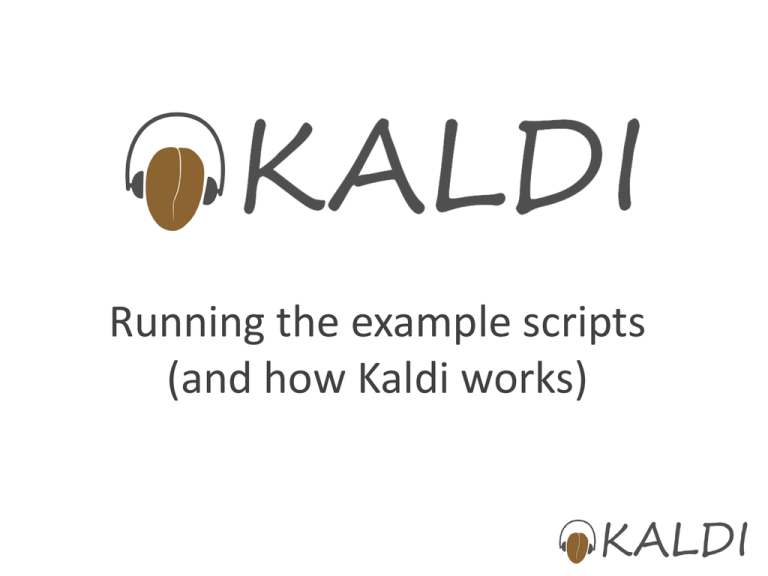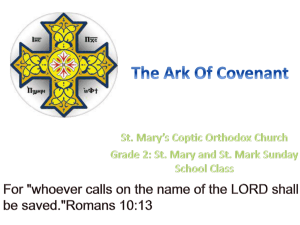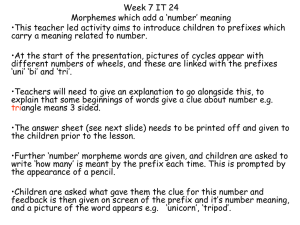here (scripts) - Kaldi
advertisement

Running the example scripts
(and how Kaldi works)
Overview of this talk
• Will be going through the process of
downloading Kaldi and running the Resource
Management (RM) example.
• Will digress where necessary to explain how
Kaldi works
• This talk covers the UNIX installation process
(installation using Visual Studio is described
in the documentation)
• The scripts are in bash (Kaldi can work with
any type of shell, but the example scripts are
done this way as many people are familiar
with this shell)
Downloading and installing Kaldi
•
•
•
•
These instructions also at kaldi.sf.net
Make sure svn (Subversion) is installed
This is a version control system, like cvs
Check out Kaldi:
svn co https://kaldi.svn.sourceforge.net/svnroot/kaldi
• Instructions in kaldi/trunk/INSTALL
• A few simple steps (run install script; configure;
make)… takes a while though
• Installs some tools the scripts require (sph2pipe,
IRSTLM, OpenFst, …), plus Kaldi
• e-mail me if it doesn’t work!
What’s in the repository
• In kaldi/trunk/ (the “current” version):
• tools/ (Installation scripts to install external
tools)
• src/ (The Kaldi source code)
•
base/, matrix/, util/, feat/, tree/, optimization/,
gmm/, transform/, sgmm/, fstext/, hmm/, lm/,
decoder/, bin/, fstbin/, gmmbin/, fgmmbin/,
sgmmbin/, featbin/
• egs/
•
•
rm/s1/ (Resource Management example dir)
wsj/s1/ (Wall Street Journal example dir)
Building and testing Kaldi
• [once tools/ installation done]
• Change directory to src/
• Configure: “./configure.sh”
• This hand-written script creates a file “kaldi.mk”
invoked by Makefiles in subdirectories
• Make: “make –j 4” [takes a while parallel]
• Programs created in subdirectories *bin/
• Test: “make test”
• Runs unit-tests that test various components
• Can also type “make valgrind” (uses valgrind to
look for memory errors in unit tests)
Running the example scripts
• We’ll talk about the Resource Management
example script.
• Obtain LDC corpus LDC93S3A
• Scripts need the directory name where you
put this.
• cd to egs/rm/s1, see run.sh
• The following slides will describe the steps in
run.sh, and what they do.
Data preparation
• cd data_prep/; ./run.sh /path/to/RM; cd ..
• Things created by this step:
# head train_sph.scp
trn_adg04_sr009 /foo/sph2pipe –f wav \
/bar/adg0_4/sr009.sph |
trn_adg04_sr009 /foo/sph2pipe –f wav \
/bar/adg0_4/sr009.sph |
...
• G.txt (bigram decoding graph, in OpenFst
text format)
Data preparation cont’d
• Lexicon in text format (a script will convert this
to FST format before being used by Kaldi):
# head lexicon.txt
A
ax
A42128
ey f ao r t uw w ah n t uw ey td
AAW
ey ey d ah b y uw
...
• Utterance to speaker (utt2spk) maps (will be
read directly by Kaldi tools… also spk2utt maps.
# head train.utt2spk
trn_adg04_sr009 adg0
trn_adg04_sr049 adg0
...
Data preparation cont’d
• Transcriptions in text format
• Note: will be converted to integer format using
symbol table, before being used by Kaldi
# head train_trans.txt
trn_adg04_sr009 SHOW THE GRIDLEY+S TRACK IN BRIGHT
ORANGE WITH HORNE+S IN DIM RED
trn_adg04_sr049 IS DIXON+S LENGTH GREATER THAN
THAT OF RANGER
...
Next steps after data_prep/
• steps/prepare_graphs.sh
• First prepares symbol-tables for words and
phones (OpenFst format):
# head data/words.txt
<eps>
0
A
1
A42128 2
AAW 3
...
# head data/phones.txt
<eps>
0
aa 1
ae 2
...
Next steps after data_prep/
• Next, this script prepares binary-format FSTs,
with integer labels only (no inbuilt symbol
tables)
• data/G.fst, data/L.fst, data/L_disambig.fst
• G is the grammar, L is the lexicon.
• The lexicon includes silence.
• L_disambig.fst includes “disambiguation
symbols” (search online for hbka.pdf and
read Mohri’s paper to find out what these
are).
Next steps after data_prep/
• Also prepares files that contain lists of integer
id’s of silence and non-silence phones
• These are needed for various purposes by the
training and testing scripts
# cat data/silphones.csl
48
# cat data/nonsilphones.csl
1:2:3:4:5:6:7:8:9:10:11:12:13:14:15:16:17:18:19:20:21:22
:23:24:25:26:27:28:29:30:31:32:33:34:35:36:37:38:39:40:4
1:42:43:44:45:46:47
Computing raw MFCC features
mfccdir=/big/disk/mfccdir
steps/make_mfcc_train.sh $mfccdir
steps/make_mfcc_test.sh $mfccdir
• An example of the actual command that one
of these scripts runs is:
compute-mfcc-feats –use-energy=false \
scp:data/train_wav.scp \
ark,scp:/foo/raw_mfcc.ark,/foo/raw_mfcc.scp
• “ark”==archive, “scp”==script file
• Data goes in single large archive file.
Script and archive files…
# head /foo/raw_mfcc.scp
trn_adg04_sr009 /foo/raw_mfcc.ark:16
trn_adg04_sr049 /foo/raw_mfcc.ark:23395
...
# head –c 20 foo/raw_mfcc.ark
trn_adg04_sr009 ^@BFM [binary data...]
• Archive format is [key] [object] [key]
[object]…
• Archives may contain binary or text data
• Text archives are often line-by-line (depends
on text form of the object).
Script and archive files…
• Script format is [key] [extended-filename]\n
[key] [extended-filename]\n …
• In general, extended filenames include
“/file/name”, “some command|”, “|some
command”, “-”, “/offset/into/file:12343”
• To understand how we deal with scripts and
archive, need to understand the “Table”
concept…
The Table concept
• A Table is a collection of objects (of some
known type), indexed by a “key”.
• A “key” is a nonempty, space-free string, e.g.
“trn_adg04_sr009” (an utterance), “adg04”
(a speaker)
• There is no single C++ class corresponding to
a table…
• There are three (templated) Table classes:
TableWriter
SequentialTableReader
RandomAccessTableReader
The Table concept + templates
• The Table is templated, but not on the type of
object it holds.
• It’s templated on a class we call a “Holder”
class, which contains a typedef Holder::T that is
the actual type the Table holds.
• E.g. “Int32VectorHolder” is a name of a Holder
class.
• The Holder class tells the Table code how to
read and write objects of that type
• I.e. it has appropriate Read and Write functions
The Table concept: example
• Suppose in your program you want to read,
sequentially, objects of type std::vector<int32>,
indexed by key.
• The user would provide a string (an “rspecifier”)
that tells the Table code how to read the object.
std::string rspecifier = “ark:/foo/my.ark”
SequentialTableReader<Int32VectorHolder>
my_reader(rspecifier);
for(; !my_reader.Done(); my_reader.Next()) {
std::string key = my_reader.Key();
const std::vector<int32> &value(my_reader.Value());
... do something ...
}
The Table concept: purpose
• The Table code provides a convenient I/O
abstraction (without the need for an actual
database).
• Normal Kaldi code interacts with sets of objects
(indexed by key) in three ways:
•
•
•
Writing keys and objects one by one (TableWriter)
Reading keys and objects one by one
(SequentialTableReader)
Accessing objects with random access
(RandomAccessTableReader)… this class will tell you
whether a key is in a table or not.
The Table concept: hard cases
• The Table code always ensures correctness (to do this,
it may have to read all objects into memory).
• Note: the three Table classes are actually each
polymorphic (implementation differs depending if it’s
a script-file or archive, and also other factors).
• The implementation of most cases is fairly simple
• There is one tricky situation: accessing an archive via
random access.
• The archive may be a pipe. In this case we can’t
fseek(), so would have to cache all the objects in
memory in case they’re asked for later.
• Next slide will describe how we deal with this.
The Table concept: options
• We can provide various options in the
“rspecifiers” and corresponding “wspecifiers”.
• The simplest one is specifying text-mode, e.g.
(for writing) “ark,t:foo.ark”
• Others are to make life easier for the Table code
(i.e. enable it to cache fewer objects in memory).
• E.g. “ark,s:foo.ark”: “s” asserts that the archive is
sorted on key (stops us having to read to the end
of the archive if key not present).
• Common option when reading is “s,cs”: “s”
asserts archive is sorted, “cs” that the keys are
queried in sorted order. Avoids object caching.
Computing MFCCs (cont’d)
compute-mfcc-feats –use-energy=false \
scp:data/train_wav.scp \
ark,scp:/foo/raw_mfcc.ark,/foo/raw_mfcc.scp
• Here, “scp:data/train_wav.scp” is an rspecifier
that says to interpret “data/train_wav.scp” as
a script file to read from
• “ark,scp:/foo/raw_mfcc.ark,/foo/raw_mfcc.scp”
is a wspecifier that says to write a (binary)
archive, and also a script file with offsets into
that archive (for efficient random access).
Monophone training
steps/train_mono.sh
• This script first sets up some variables…
dir=exp/mono
# create $dir/train.scp which is a data subset.
feats="ark:add-deltas scp:$dir/train.scp ark:- |"
• The variable $feats will be used as a command-line
argument to programs, treated as an rspecifier.
• The part after “ark:” is treated as an extended
filename (and since it ends with “|”, the command is
invoked and we read from the output).
• The program add-deltas writes to “ark:-”, i.e. it writes
an archive on the standard output.
Monophone training; topology
•
Next, the script creates a file $dir/topo which specifies
phone topologies.
<Topology>
<TopologyEntry>
<ForPhones>
1 2 3 4 5 6 7 8 9 10 11 12 13 14 15 16 17 18 19 20 21 22 23 24
25 26 27 28 29 30 31 32 33 34 35 36 37 38 39 40 41 42 43 44 45
46 47
</ForPhones>
<State> 0 <PdfClass> 0 <Transition> 0 0.75 <Transition> 1 0.25
</State>
<State> 1 <PdfClass> 1 <Transition> 1 0.75 <Transition> 2 0.25
</State>
<State> 2 <PdfClass> 2 <Transition> 2 0.75 <Transition> 3 0.25
</State>
<State> 3 </State>
</TopologyEntry>
# Next is the topology entry for silence, which we won’t show…
</Topology>
Monophone training; initialiation
• The next command does a flat start of the
model
gmm-init-mono $dir/topo 39
$dir/0.mdl $dir/tree
• This program also creates a “trivial” decision
tree with no splits
• Note: monophone system is treated as a
special case of a context-dependent system,
with zero phones of left and right context.
• Note: in the real scripts we redirect the
stderr into log files (all logging on stderr).
Monophone training: creating
decoding graphs
• Write an archive containing the fully expanded
FST corresponding to the transcription of each
utterance.
compile-train-graphs $dir/tree $dir/0.mdl data/L.fst \
"ark:$dir/train.tra” \
"ark:|gzip -c >$dir/graphs.fsts.gz"
• Note: the input file $dir/train.tra would
contain transcriptions in integer form, e.g.:
trn_adg04_sr009 763 843 367 879 417 75 622 974 407 417
227 694
trn_adg04_sr049 436 235 483 362 841 842 611 679
trn_adg04_sr089 763 345 842 30 88 617 881
...
Monophone training: initial alignment
align-equal-compiled \
"ark:gunzip –c $dir/graphs.fsts.gz|“ "$feats" ark:- | \
gmm-acc-stats-ali $dir/0.mdl "$feats“ ark:- dir/0.acc;
• The first command in this pipe (align-equal-compiled)
does an equally-spaced alignment of a random path
through each FST.
• Its output is an “alignment” for each utterance
• An alignment is a vector of “transition-ids”, one per
frame.
• A transition-id is like the index of a p.d.f., but with a bit
more information encoded in it (the phone, etc.)
• The program gmm-acc-stats-ali accumulates stats for
GMM training, given alignments.
gmm-est $dir/0.mdl $dir/0.acc $dir/1.mdl;
Monophone training
• On selected iterations of training, re-align training data
(Viterbi alignment):
gmm-align-compiled –beam=8 --retry-beam=40 \
$dir/$x.mdl "ark:gunzip -c $dir/graphs.fsts.gz|“ \
"$feats" ark,t:$dir/cur.ali
•
•
•
•
Realign almost every iteration during monophone phase
Typically only about 3-4 times during triphone training.
Mixing-up is an option to the update program.
Gaussians allocated according to an overall budget we
provide, proportional to g0.2,where g is the data count
• E.g.: increase this budget linearly for 15 iterations, then
leave it fixed for another 15.
Triphone training
• First stage is to align all the data with monophone model
gmm-align --beam=8 --retry-beam=40 exp/mono/tree \
exp/mono/30.mdl data/L.fst "$feats" \
ark:data/train.tra ark:exp/tri1/0.ali
• Next accumulate stats for training the decision tree:
acc-tree-stats --ci-phones=48 exp/mono/30.mdl \
"$feats" ark:exp/tri/0.ali exp/tri/treeacc
Triphone training: questions etc.
• Automatically generate sets of phones that will be
“questions”, via tree clustering (do binary splitting of
phones, and get questions of all sizes).
cat data/phones.txt | awk '{print $NF}' | \
grep -v -w 0 > exp/tri/phones.list
cluster-phones exp/tri/treeacc exp/tri/phones.list \
exp/tri/questions.txt
compile-questions exp/tri/topo exp/tri/questions.txt \
exp/tri/questions.qst
• Create file that specifies tree “roots”: in this case, one
per phone (but could have shared roots).
scripts/make_roots.pl --separate data/phones.txt
$silphonelist shared split \
> exp/tri/roots.txt
\
Triphone training: building tree
• Build the decision tree
build-tree --max-leaves=1500 exp/tri/treeacc \
exp/tri/roots.txt exp/tri/questions.qst \
exp/tri/topo exp/tri/tree
• Initialize the model for this tree
gmm-init-model exp/tri/tree exp/tri/treeacc \
exp/tri/topo exp/tri/1.mdl
• Convert alignments generated from the monophone
system to be consistent with the new tree:
convert-ali exp/mono/30.mdl exp/tri/1.mdl \
exp/tri/tree ark:exp/tri/0.ali ark:exp/tri/cur.ali
• Rest of training similar to monophone case.
Decoding: building the graph
• Script to build graph is invoked by:
scripts/mkgraph.sh exp/tri/tree exp/tri/30.mdl \
exp/graph_tri
•
Compose L (lexicon) with G (grammar), determinize, minimize
fsttablecompose data/L_disambig.fst data/G.fst | \
fstdeterminizestar --use-log=true | \
fstminimizeencoded > exp/tri/LG.fst
• Get list of disambiguation symbols:
grep '#' data/phones_disambig.txt | \
awk '{print $2}' > $dir/disambig_phones.list
• This file now contains “49\n50\n51\n”.
Decoding: building the graph, cont’d
• Compose (dynamically generated) C with LG:
fstcomposecontext \
--read-disambig-syms=$dir/disambig_phones.list \
--write-disambig-syms=$dir/disambig_ilabels.list \
$dir/ilabels < $dir/LG.fst >$dir/CLG.fst
•
•
•
•
The input symbols of CLG.fst represent context-dependent
phones. [note: command above defaults to trigram]
The file $dir/ilabels contains the information that maps these
symbol id’s to phonetic-context windows.
Next command generates the “H” tranducer...
actually Ha is H without self-loops.
make-h-transducer --disambig-syms-out=$dir/tstate.list \
$dir/ilabels exp/tri/tree exp/tri/model \
> $dir/Ha.fst
Decoding: building the graph, cont’d
• … the transducer Ha.fst has “transition-ids” as its input
symbols and context-dependent phones as output.
• transition-ids are like p.d.f. indexes, but also guarantee to
encode the phone, HMM-position etc.
• Compose Ha with CLG, determinize, remove
disambiguation symbols , remove epsilons, minimize:
fsttablecompose $dir/Ha.fst $dir/CLG2.fst | \
fstdeterminizestar --use-log=true \
| fstrmsymbols $dir/tstate.list | fstrmepslocal | \
fstminimizeencoded > $dir/HCLGa.fst
• Add self loops to get final graph:
add-self-loops exp/tri/30.mdl \
< $dir/HCLGa.fst > $dir/HCLG.fst
Decoding: decoding command
• First set up the features variable (shell variable)
feats="ark:add-deltas scp:data/test_feb89.scp ark:- |"
• Decode:
gmm-decode-faster --beam=20.0 --acoustic-scale=0.08333 \
--word-symbol-table=data/words.txt exp/tri/30.mdl \
exp/graph_tri/HCLG.fst “$feats” \
ark,t:exp/decode_tri/test_feb89.tra \
ark,t:exp/decode_tri/test_feb89.ali
• Note: this command outputs state-level traceback
• We can use this to compute transforms
• Decode again with separate command.
Summary (scripts)
• Have described the simplest path through
the scripts
• Have summarized some of Kaldi’s I/O
mechanisms
• Have given some idea of how training and
decoding works in Kaldi







